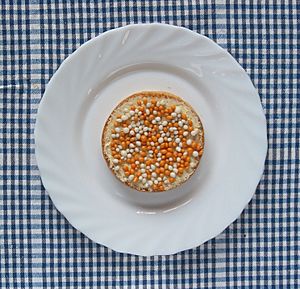Muisjes facts for kids
| Place of origin | Netherlands |
|---|---|
| Main ingredients | Aniseed, sugar |
Muisjes (which means "little mice" in Dutch) are a special kind of sweet sprinkle. They are a traditional Dutch topping for bread. People often eat them on beschuit (pronounced "buh-SKOWT"), which is a type of crispy, round rusk. Muisjes are made from aniseeds. These seeds are covered in a sugary, colorful layer.
Today, only one Dutch company, De Ruijter, makes Muisjes. This brand became part of Heinz in 2001.
Contents
Why are they called "Muisjes"?
It's not totally clear why these sprinkles are called "little mice." Some people think the small stem of the aniseed looks like a mouse's tail. Others believe it's because mice have many babies quickly. This might have been a symbol for healthy childbirth. In Belgium, the name can also refer to mouse droppings.
Celebrating New Babies with Muisjes
In the Netherlands, there's a lovely tradition when a baby is born. Families eat beschuit met muisjes (rusk with muisjes). The anise in the muisjes was once thought to help mothers. It was believed to encourage milk production and help the mother's body recover.
Older brothers and sisters often take beschuit met muisjes to school. They share them with their classmates. Parents also share them with their co-workers. This is a sweet way to celebrate the new baby.
The idea of giving away muisjes after a birth is very old. It probably comes from traditions in the Middle Ages. Back then, childbirth was very risky for women. So, a birth without problems was a huge reason to celebrate. People would give visitors a sweet treat. This was like a "gift" from the new baby.
Muisjes started being made in the Netherlands in the 1700s. They became a popular topping for beschuit to celebrate successful births. At first, beschuit was quite expensive. Only wealthy families could afford it for celebrations. Most people used sugary white bread instead. Later, beschuit became cheaper for everyone.
In 1860, pink muisjes were introduced. They became the standard for baby girls. The original white muisjes were then used for baby boys. But in 1994, blue muisjes were created. Since then, blue muisjes are used for boys. Pink muisjes are still used for girls.
De Ruijter is the biggest company making muisjes. They have been producing them since 1860. The company helped make beschuit met muisjes even more popular. This happened in 1938 when the Dutch royal family received a large can of orange muisjes. This was to celebrate the birth of Princess Beatrix. Orange is the color of the Dutch royal family. Orange muisjes were sold again for just one week in December 2003. This was to honor the birth of Princess Catharina-Amalia.
Crushed Muisjes for Breakfast
Gestampte muisjes means "crushed muisjes." These are muisjes that have been ground into a powder. Children in the Netherlands often eat them for breakfast. They sprinkle the crushed muisjes over a slice of bread or a Dutch rusk. They usually put butter on the bread first.
See also
 In Spanish: Muisjes para niños
In Spanish: Muisjes para niños


